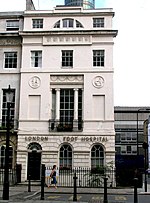George and Dragon, Fitzrovia
FitzroviaGrade II listed buildings in the London Borough of CamdenGrade II listed pubs in LondonLondon building and structure stubsPub stubs ... and 4 more
Pubs in the London Borough of CamdenSaint George and the DragonUnited Kingdom listed building stubsUse British English from October 2014

The George and Dragon is a Grade II listed public house at 151 Cleveland Street, Fitzrovia, London W1T 6QN.It was built in about 1850.
Excerpt from the Wikipedia article George and Dragon, Fitzrovia (License: CC BY-SA 3.0, Authors, Images).George and Dragon, Fitzrovia
Cleveland Street, London Fitzrovia (London Borough of Camden)
Geographical coordinates (GPS) Address External links Nearby Places Show on map
Geographical coordinates (GPS)
| Latitude | Longitude |
|---|---|
| N 51.522959 ° | E -0.142092 ° |
Address
The George & Dragon
Cleveland Street 151
W1T 6QN London, Fitzrovia (London Borough of Camden)
England, United Kingdom
Open on Google Maps









